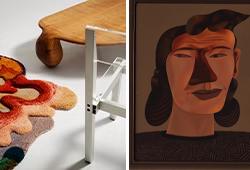Öyvind Fahlström
Öyvind Fahlström, mapp med serigrafier, 10 st, "Opera". Upplaga 400.
Mapp i kartong. Bladen ligger lösa inuti tillsammans med ett försättsblad. Utgiven 1968 av Riksutställningar och tryckt av BMJ Silkscreentryckeri i Stockholm. Bladstorlek 92 x 20 cm.
Portfolion något blekt och med smärre fläckar. Slitage i hörnen. Bladen ser ut att vara i fint skick, har ej gåtts igenom individuellt.
Övrig information
"Opera began with my discovery of the felt-tip pen in 1952. With this I could work not only with a fairly precise, even blackness, like India ink, but also with gradations of gray which were not fuzzy like pencil drawings. The felt-tip also produced random textures. The pleasurable "spontaneity" of that working method began to feel monotonous after awhile. I began to putting together some of the sheets on which I had drawn, and I could see continuity and larger themes begin to appear. I also saw that various different ideas joined together as an entity produced shifts: unexpected, "unnatural" events on the paper.
At the time I was interested in Pre-Columbian Mexican book-paintings which moved from page to page in long panels folded in concertina fashion. I was also interested in music. As a visual artist I lacked the dimension of time that exists in music. I particularly like the "impure" mix of concert and theatre to be found in opera (The Ring of the Nibelungs, for example). I realized how, as in much primitive, oriental and medieval art, one could work with pictures which were so full and so extensive that it was impossible to take that step backwards, screw up one's eyes and enjoy the whole...I wanted to get people to move not just their eyes but their whole person along and around in the picture as if they were reading a map or playing Monopoly or football.
The game concept was my current interest at the time I was writing the manifesto for concrete literature. There as well I expressed my impatience with the monotony and private nature of pure automatism. One ought to be able to make simple rules for oneself, create frames of reference within the work of art. The simplest fundamental rule in Opera was repetition. It felt then like a big discovery; not merely a continuous sequence of constantly changing motifs, but a decision -- this one is important, this shall have a role. Recurring in new contexts and recurring altered, but still recognizable.
That is how the character-form originated -- the abstract form where type was so pronounced that it was recognizable, but which at the same time was put together so that its many suggested meanings kept one another in check, thus preserving the character-form's ambiguity. I had seen Capogrossi's special comb-like form which he repeated in painting after painting. And Matta's robot-human-image-machines which to me were the most fascinating works created in the visual arts at the time.
Opera gradually developed a more or less principal character, the caterpillar-like being with the big "head" and a "bump" in the middle. It appears more often in the latter part of the work. It is "threatened" by the shape which resembles a halberd or an axe. (A less ambiguous element, almost representational in its lopsidedness towards "something which cuts.") Finally the caterpillar character bursts.
At the end, other typical elements can also be seen: the rhythmic, ornamental repetition of "the arcade sign", for example, which beats its rhythm against the bottom image's dactylic rhythm and the chaotic small-conglomeration's long rows. The tension between the conglomeration's chaotic, spontaneous interior and its exterior straight-rowed discipline which, towards the end, steps down in two beats in a single counterpoint against the light "poles" with the main character-form. (The actual ending was inspired by a description of a piece by the 15th century composer De Prés.)
Why is the character-form which I mentioned important? Because it was put into a climax or other important context. (I seem to remember that I called it the "sublime character-form.")
Finally, one can also see character-forms which are fragmented on a large window panel. That was the beginning of the decomposition technique which I later implemented with hundreds and thousands of elements in the Kalas drawings and in the painting, Dr. Livingstone.
Through the long shape of the drawing the reading movement became, for the most part, clear in Opera . At a later point when I created more readily accessible paintings, like Sitting... in 1962, I was seeking to steer them by introducing panels as if in a drawn series. At one place in Opera there is a picture with four frames wherein the caterpillar sign passes through various voids (the reading direction is indicated by the small four-frame field below).
Thus Opera functioned by its length and flexible technique (felt-tip pen and India ink) as an experimental field for various working methods, ideas and concepts which were to be developed in later works. And now that it is being distributed in an unsigned edition, one of my favorite ideas is realized and my solitary fetishistic isolation is no more.
Öyvind Fahlström"
Text från fahlstrom.com


























